Report on the visit of the presentation of the Lviv IT Cluster in Palo Alto, California
He attended the presentation of the Lviv IT Cluster in Palo Alto, California. The presentation took place in Palo Alto, in the community center, where I once attended Japanese language courses.
The meeting was advertised on Facebook and twenty people came to it, among them were programmers from Facebook and Microsoft, representatives of companies leading outsourcing business with Ukraine, me and Sergey Vakulenko from Imagination Technologies, analog electronics engineer from KLA-Tencor, girl- graphic designer, programmer from a medical company and others. 100% of those present owned the Ukrainian language.
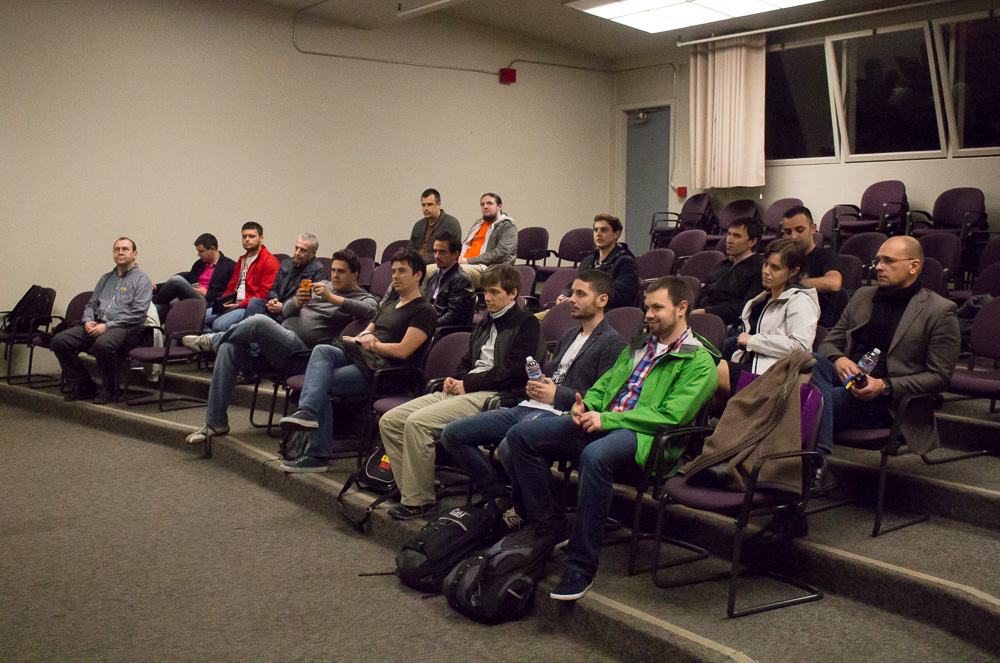
The meeting was organized by Ostap Korkun from Facebook. Three people arrived from Lvov, of which Stepan Veselovsky , the CEO of the IT Cluster, was presenting.
')
In terms of the habits and spirit of the presentation, comrades from Western Ukraine reminded me of all sorts of Eastern Europeans, with whom I occasionally work here at Silicon Valley. When I worked in the American branch of the Singapore-based Creative Labs company in 1994, I had a Hungarian chief, a direct manager, a Pole, and the closest friend of Romania. It is from these comrades the same feeling, but at an earlier stage and with the Ukrainian language.

The objectives of the Lviv IT Cluster are:
1. Construction of a community of programmers in Lviv and a branch of such a community in the form of a network of contacts in Silicon Valley, as well as its connection with other clusters in Kiev, Dnepropetrovsk, Kharkov and Odessa.
2. Initiation of tectonic changes in the Ukrainian education system. As far as I understand the point of view of Stepan, he considers the modern Ukrainian education system to be non-reformable and wants to grow some parallel programs better connected with the world and Ukrainian reality.
3. Solving programmers' everyday problems with the help of housing construction subsidized by companies. Stepan talked about this for a long time, but it was tempting to ask me “what if a programmer buys a subsidized apartment, after which he quits the company and refuses to move out of the apartment, pointing to a pregnant wife and frost on the street?” But I suppressed the desire to start Russian / Ukrainian real estate disputes, because I know that in Silicon Valley they last a long time.

Stepan's story about the life of Lviv companies was interesting, but his slides do not correspond to the local audience:
1. In the slides there are elements that most of Stepan’s potential partners in Silicon Valley are simply indifferent, for example, how many Lviv programmers drink coffee a day. Oh, I understand that even in Wikipedia it is written that the creative class is obliged to go to coffee shops but nonetheless.
2. Or here is the Big Mac index. I immediately recall how in 1996 one manager at Mentor Graphics negotiated with the Russian partner about remuneration for writing the processor simulator Hitachi SH, and the Russian partner gave some arguments about the cost of sausage in Dolgoprudny (I was in this correspondence in CC) . The American manager was annoyed with such negotiations.
3. But the point that may scare away some sensitive Americans: what percentage of income does Lviv programmers spend on supporting the Ukrainian army. Perhaps it was these slides that were the reason why last year Xilinx stopped supplying educational FPGA cards to Ukraine, which Xilinx supplies to communist China and even (with restrictions) to Russia. American companies do not want to take sides in any armed conflicts between non-NATO members.
4. Also, the local people in Silicon Valley might not understand what the coolness of the fact that 7 out of 10 Lviv programmers were abroad. Were in as whom? On tourist trips? So how does this affect the acquisition of competitive advantage in programming?
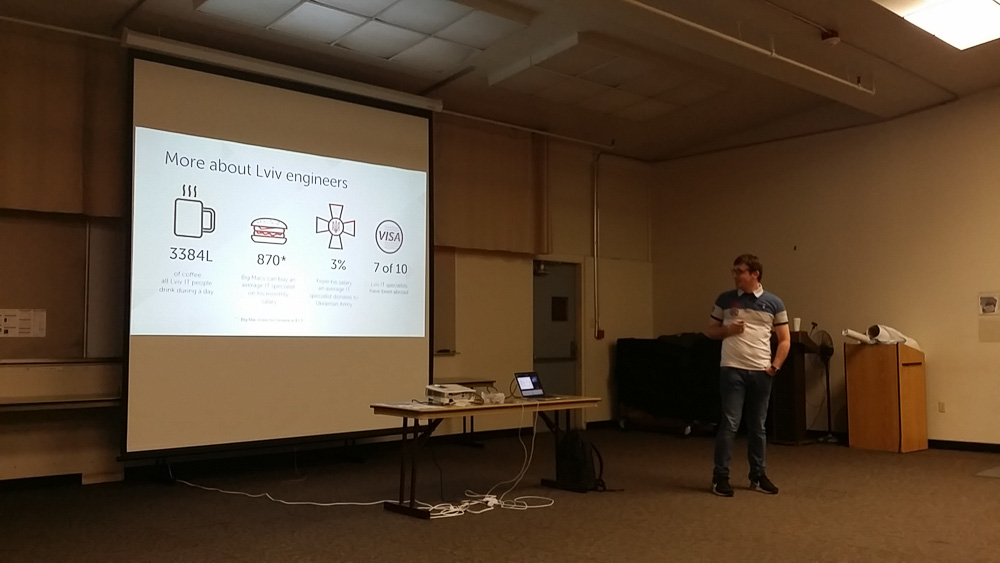
5. The presentation was a slide about the ratio of outsourcing companies and product companies, but there were no slides with a breakdown of companies by technology niches. Let us dwell on this point in more detail. Even at the 2013 Ukrainian conference in San Francisco, I noticed that the Ukrainian ecosystem is dominated by several large outsourcing companies that sell the same services: business programming, web programming, and a bit of embedded programming. From my point of view, such a “commoditization” of programmers is dangerous during crises, because when everyone does the same thing, then when demand drops, panic occurs. A more diversified system, especially with a larger share of product companies, is more sustainable and also provides its participants with a wider range of interesting professions. I wanted to understand whether there was progress in this direction in two years, but on Stepan’s slides this information was not.
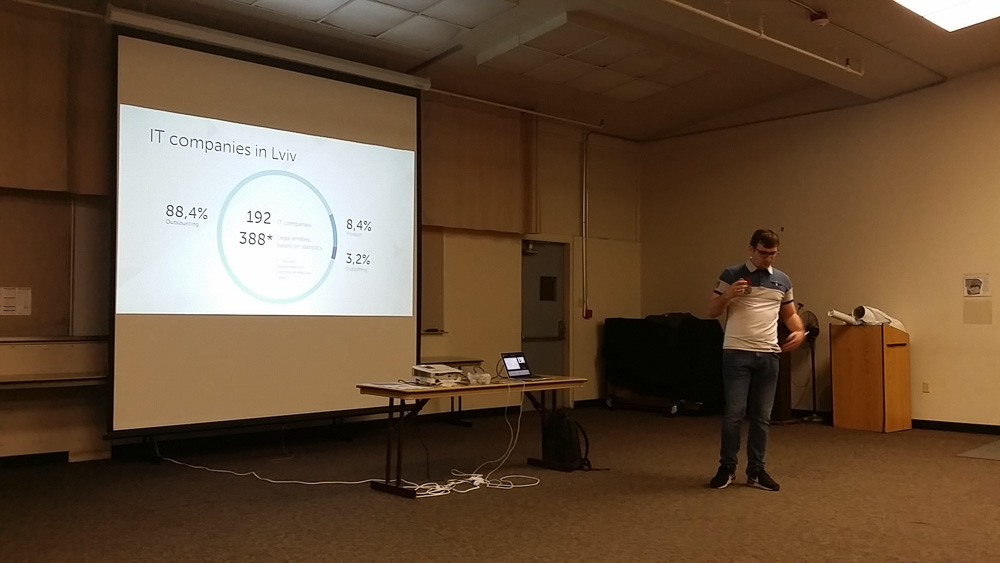
The most interesting for me was the discussion about educational programs initiated by the Lviv IT-cluster. In particular, Stepan said that they are planning to introduce the educational program "Internet of Things" (Internet of Things, IoT). This interested me, since our company Imagination Technologies and our partner in microcontrollers, Microchip Technology, have long been engaged in educational programs in the field of the Internet of things, we sponsored the creation of a course on microcontrollers at the University of North Carolina, I talked about related topics in Skolkovo and MIPT and etc. In particular, two years ago I gave a presentation on the Internet of Things at the Russian high-tech conference in Arizona:
http://silicon-russia.com/public_materials/2014_03_03_ruscitech/ruscitech_yuri_panchul_imgtec_march_2014_with_appendix.pdf
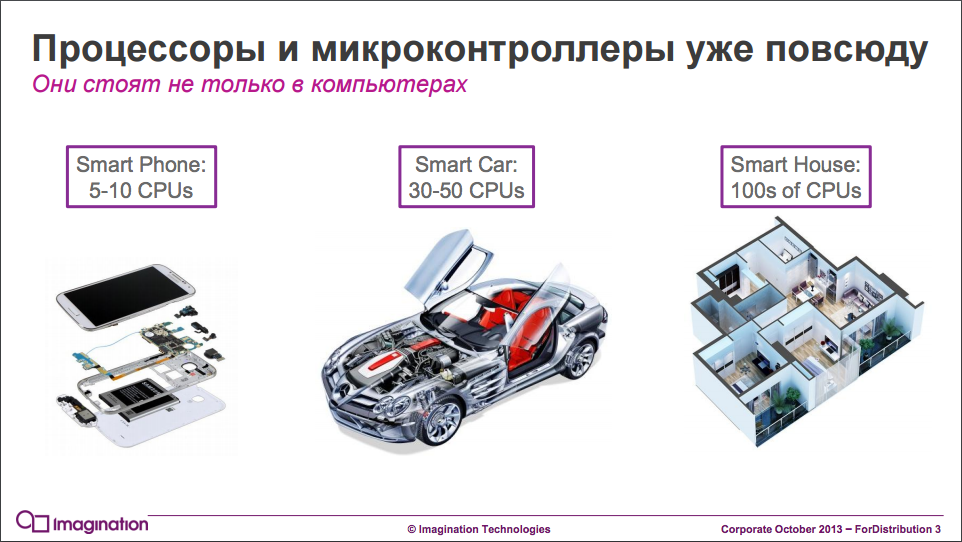
I told Stepan that many Russian universities are now introducing IoT programs, and I noticed that they sometimes make the mistake of distributing three IoT levels to different faculties or even to different universities:
1. The level of applications - to collect all sorts of beautiful toys from ready-made components - both hardware and software. Often used in conjunction with business and creativity training.
2. The level of basic and supporting technologies - microcontroller architecture and embedded microprocessors, embedded real-time operating systems, interface protocols, etc.
3. The level of the internal devices of the chips, which are the heart of the Internet of Things Yes, this is possible, and even at the level of laboratory work. The MIPSfpga package allows students to experiment with the internals of the MIPS microAptiv UP processor core, for example, in a new platform for the Internet of Things, called Samsung Artik-1 . Experiments with MIPSfpga are made on educational boards with FPGAs - microcircuits, which are matrixes of cells, the logical functions of which can be redefined.
I asked Stepan if they were going to teach all three levels of understanding in universities, to which he said that the program was being developed.
Then I showed Stepan some materials from our company Imagination Technologies and our partners - Microchip Technology and Digilent. Our company designed the PowerVR GPU inside the microcircuit inside the Apple iPhone, so you get the materials from the leading edge.
First of all, the brochure of educational programs:
http://community.imgtec.com/university
https://s3-eu-west-1.amazonaws.com/imagination-technologies-cloudfront-assets/university/IUP_Brochure_v1.2.pdf
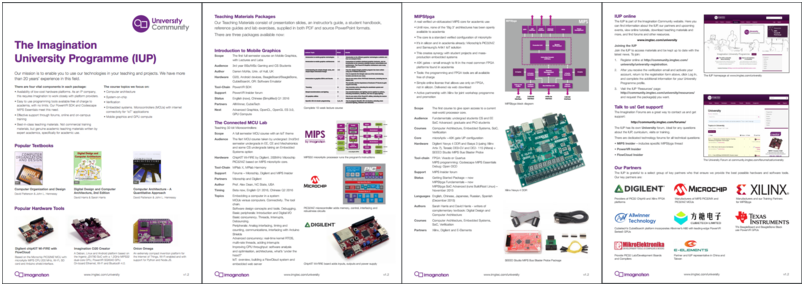
Slides about educational programs in Russian:
http://silicon-russia.com/public_materials/2015_11_14_mipsfpga_related_presentations/imagination_university_programme_july_2015_russian.pdf
Slides about a new course on programming microcontrollers - Connected MCU. This course is being developed by University of North Carolina professor Alex Dean, in cooperation with industrial companies - Imagination Technologies, Microchip Technology and Digilent. Now the course as a whole is completed and is in the process of being reviewed by a couple of dozens of world universities in the UK, China, etc. I managed to involve some Russian universities in the review process. They liked the course - it was made solidly, with analysis of the architecture of the core and the periphery of the microcontroller, professional introduction to the use of embedded RTOS, etc. It is possible to involve Ukrainian universities in the review process; if there is enough time, it is useful to present them to the management in the organizations listed above. Imagination has a branch in Poland, Digilent has a branch in Romania, so the idea of working with Ukraine can be accepted. I am a member of the course design committee:
http://silicon-russia.com/public_materials/2015_11_14_mipsfpga_related_presentations/connected_mcu_by_alex_dean_on_microchip_masters_v3_2015.pdf

At the same time, I know, but in Ukraine there are many fans of alternative ways of teaching IoT - using Arduino, Raspberry Pi, Intel Galileo, STM32, etc. etc. I will not even try to persuade them, because besides teaching programming, microcontrollers and embedded processors, I have two things that can be learned regardless of the personal preferences of teachers of embedded programming courses.
First of all, it is a free textbook on electronics, computer architecture and low-level programming in Russian - David Harris and Sarah Harris, “Digital Circuit Design and Computer Architecture”, second edition. This textbook was published in English in 2012 and Russian in 2015. The post about the textbook received more than 120,000 views on Habré http://habrahabr.ru/post/259505/ and was immediately used by teachers at the Moscow Institute of Physics and Technology, Moscow Technical Technical University, ITMO and other leading Russian universities. And Ukrainian - one of the main participants in the translation was a teacher of the Kiev National University. Taras Shevchenko Alexander Barabanov:
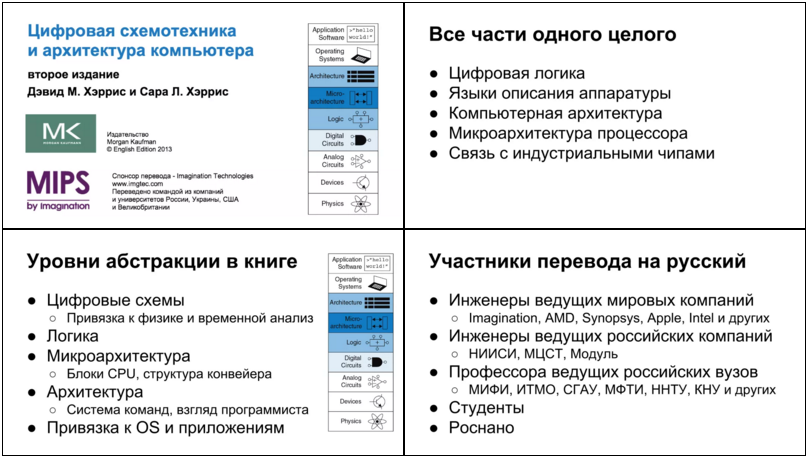
For senior courses, you can try the MIPSfpga package, which not only President Stanford John Hennessy responded well to, but also professors from Russian universities - Moscow State University, MIPT, MIET, ITMO .
I think that raising the microelectronics development ecosystem in Ukraine, as in all countries of the former USSR and Eastern Europe, will increase the well-being of the region, and provide an opportunity for a large number of young people to work on interesting jobs. It will be interesting to follow further Ukrainian presentations in the Valley.
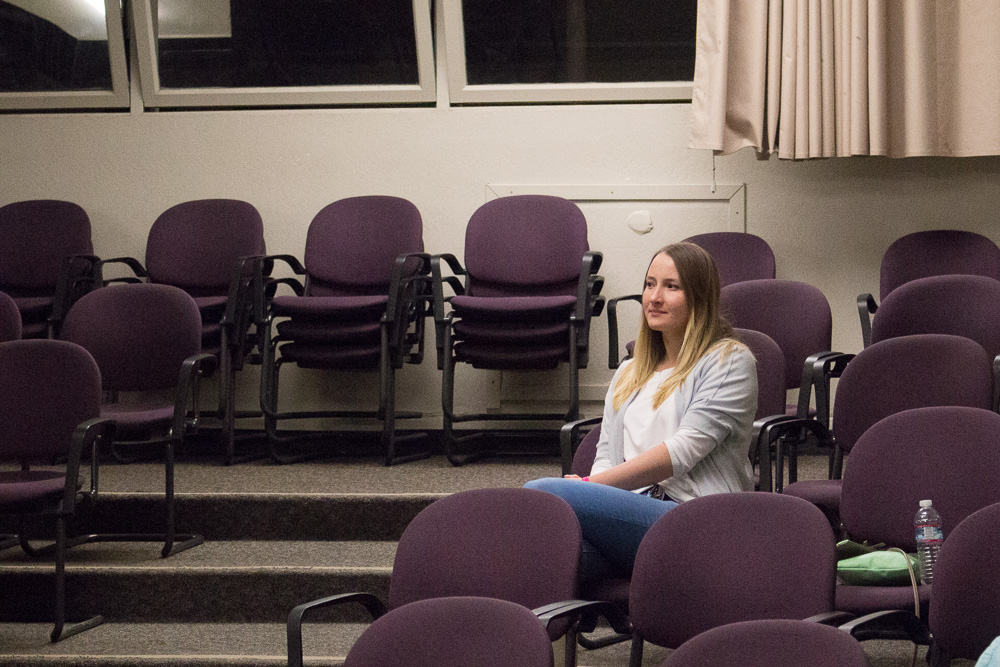
The meeting was advertised on Facebook and twenty people came to it, among them were programmers from Facebook and Microsoft, representatives of companies leading outsourcing business with Ukraine, me and Sergey Vakulenko from Imagination Technologies, analog electronics engineer from KLA-Tencor, girl- graphic designer, programmer from a medical company and others. 100% of those present owned the Ukrainian language.
The meeting was organized by Ostap Korkun from Facebook. Three people arrived from Lvov, of which Stepan Veselovsky , the CEO of the IT Cluster, was presenting.
')
In terms of the habits and spirit of the presentation, comrades from Western Ukraine reminded me of all sorts of Eastern Europeans, with whom I occasionally work here at Silicon Valley. When I worked in the American branch of the Singapore-based Creative Labs company in 1994, I had a Hungarian chief, a direct manager, a Pole, and the closest friend of Romania. It is from these comrades the same feeling, but at an earlier stage and with the Ukrainian language.
The objectives of the Lviv IT Cluster are:
1. Construction of a community of programmers in Lviv and a branch of such a community in the form of a network of contacts in Silicon Valley, as well as its connection with other clusters in Kiev, Dnepropetrovsk, Kharkov and Odessa.
2. Initiation of tectonic changes in the Ukrainian education system. As far as I understand the point of view of Stepan, he considers the modern Ukrainian education system to be non-reformable and wants to grow some parallel programs better connected with the world and Ukrainian reality.
3. Solving programmers' everyday problems with the help of housing construction subsidized by companies. Stepan talked about this for a long time, but it was tempting to ask me “what if a programmer buys a subsidized apartment, after which he quits the company and refuses to move out of the apartment, pointing to a pregnant wife and frost on the street?” But I suppressed the desire to start Russian / Ukrainian real estate disputes, because I know that in Silicon Valley they last a long time.
Stepan's story about the life of Lviv companies was interesting, but his slides do not correspond to the local audience:
1. In the slides there are elements that most of Stepan’s potential partners in Silicon Valley are simply indifferent, for example, how many Lviv programmers drink coffee a day. Oh, I understand that even in Wikipedia it is written that the creative class is obliged to go to coffee shops but nonetheless.
2. Or here is the Big Mac index. I immediately recall how in 1996 one manager at Mentor Graphics negotiated with the Russian partner about remuneration for writing the processor simulator Hitachi SH, and the Russian partner gave some arguments about the cost of sausage in Dolgoprudny (I was in this correspondence in CC) . The American manager was annoyed with such negotiations.
3. But the point that may scare away some sensitive Americans: what percentage of income does Lviv programmers spend on supporting the Ukrainian army. Perhaps it was these slides that were the reason why last year Xilinx stopped supplying educational FPGA cards to Ukraine, which Xilinx supplies to communist China and even (with restrictions) to Russia. American companies do not want to take sides in any armed conflicts between non-NATO members.
4. Also, the local people in Silicon Valley might not understand what the coolness of the fact that 7 out of 10 Lviv programmers were abroad. Were in as whom? On tourist trips? So how does this affect the acquisition of competitive advantage in programming?
5. The presentation was a slide about the ratio of outsourcing companies and product companies, but there were no slides with a breakdown of companies by technology niches. Let us dwell on this point in more detail. Even at the 2013 Ukrainian conference in San Francisco, I noticed that the Ukrainian ecosystem is dominated by several large outsourcing companies that sell the same services: business programming, web programming, and a bit of embedded programming. From my point of view, such a “commoditization” of programmers is dangerous during crises, because when everyone does the same thing, then when demand drops, panic occurs. A more diversified system, especially with a larger share of product companies, is more sustainable and also provides its participants with a wider range of interesting professions. I wanted to understand whether there was progress in this direction in two years, but on Stepan’s slides this information was not.
The most interesting for me was the discussion about educational programs initiated by the Lviv IT-cluster. In particular, Stepan said that they are planning to introduce the educational program "Internet of Things" (Internet of Things, IoT). This interested me, since our company Imagination Technologies and our partner in microcontrollers, Microchip Technology, have long been engaged in educational programs in the field of the Internet of things, we sponsored the creation of a course on microcontrollers at the University of North Carolina, I talked about related topics in Skolkovo and MIPT and etc. In particular, two years ago I gave a presentation on the Internet of Things at the Russian high-tech conference in Arizona:
http://silicon-russia.com/public_materials/2014_03_03_ruscitech/ruscitech_yuri_panchul_imgtec_march_2014_with_appendix.pdf
I told Stepan that many Russian universities are now introducing IoT programs, and I noticed that they sometimes make the mistake of distributing three IoT levels to different faculties or even to different universities:
1. The level of applications - to collect all sorts of beautiful toys from ready-made components - both hardware and software. Often used in conjunction with business and creativity training.
2. The level of basic and supporting technologies - microcontroller architecture and embedded microprocessors, embedded real-time operating systems, interface protocols, etc.
3. The level of the internal devices of the chips, which are the heart of the Internet of Things Yes, this is possible, and even at the level of laboratory work. The MIPSfpga package allows students to experiment with the internals of the MIPS microAptiv UP processor core, for example, in a new platform for the Internet of Things, called Samsung Artik-1 . Experiments with MIPSfpga are made on educational boards with FPGAs - microcircuits, which are matrixes of cells, the logical functions of which can be redefined.
I asked Stepan if they were going to teach all three levels of understanding in universities, to which he said that the program was being developed.
Then I showed Stepan some materials from our company Imagination Technologies and our partners - Microchip Technology and Digilent. Our company designed the PowerVR GPU inside the microcircuit inside the Apple iPhone, so you get the materials from the leading edge.
First of all, the brochure of educational programs:
http://community.imgtec.com/university
https://s3-eu-west-1.amazonaws.com/imagination-technologies-cloudfront-assets/university/IUP_Brochure_v1.2.pdf
Slides about educational programs in Russian:
http://silicon-russia.com/public_materials/2015_11_14_mipsfpga_related_presentations/imagination_university_programme_july_2015_russian.pdf
Slides about a new course on programming microcontrollers - Connected MCU. This course is being developed by University of North Carolina professor Alex Dean, in cooperation with industrial companies - Imagination Technologies, Microchip Technology and Digilent. Now the course as a whole is completed and is in the process of being reviewed by a couple of dozens of world universities in the UK, China, etc. I managed to involve some Russian universities in the review process. They liked the course - it was made solidly, with analysis of the architecture of the core and the periphery of the microcontroller, professional introduction to the use of embedded RTOS, etc. It is possible to involve Ukrainian universities in the review process; if there is enough time, it is useful to present them to the management in the organizations listed above. Imagination has a branch in Poland, Digilent has a branch in Romania, so the idea of working with Ukraine can be accepted. I am a member of the course design committee:
http://silicon-russia.com/public_materials/2015_11_14_mipsfpga_related_presentations/connected_mcu_by_alex_dean_on_microchip_masters_v3_2015.pdf
At the same time, I know, but in Ukraine there are many fans of alternative ways of teaching IoT - using Arduino, Raspberry Pi, Intel Galileo, STM32, etc. etc. I will not even try to persuade them, because besides teaching programming, microcontrollers and embedded processors, I have two things that can be learned regardless of the personal preferences of teachers of embedded programming courses.
First of all, it is a free textbook on electronics, computer architecture and low-level programming in Russian - David Harris and Sarah Harris, “Digital Circuit Design and Computer Architecture”, second edition. This textbook was published in English in 2012 and Russian in 2015. The post about the textbook received more than 120,000 views on Habré http://habrahabr.ru/post/259505/ and was immediately used by teachers at the Moscow Institute of Physics and Technology, Moscow Technical Technical University, ITMO and other leading Russian universities. And Ukrainian - one of the main participants in the translation was a teacher of the Kiev National University. Taras Shevchenko Alexander Barabanov:
For senior courses, you can try the MIPSfpga package, which not only President Stanford John Hennessy responded well to, but also professors from Russian universities - Moscow State University, MIPT, MIET, ITMO .
I think that raising the microelectronics development ecosystem in Ukraine, as in all countries of the former USSR and Eastern Europe, will increase the well-being of the region, and provide an opportunity for a large number of young people to work on interesting jobs. It will be interesting to follow further Ukrainian presentations in the Valley.
Source: https://habr.com/ru/post/299288/
All Articles